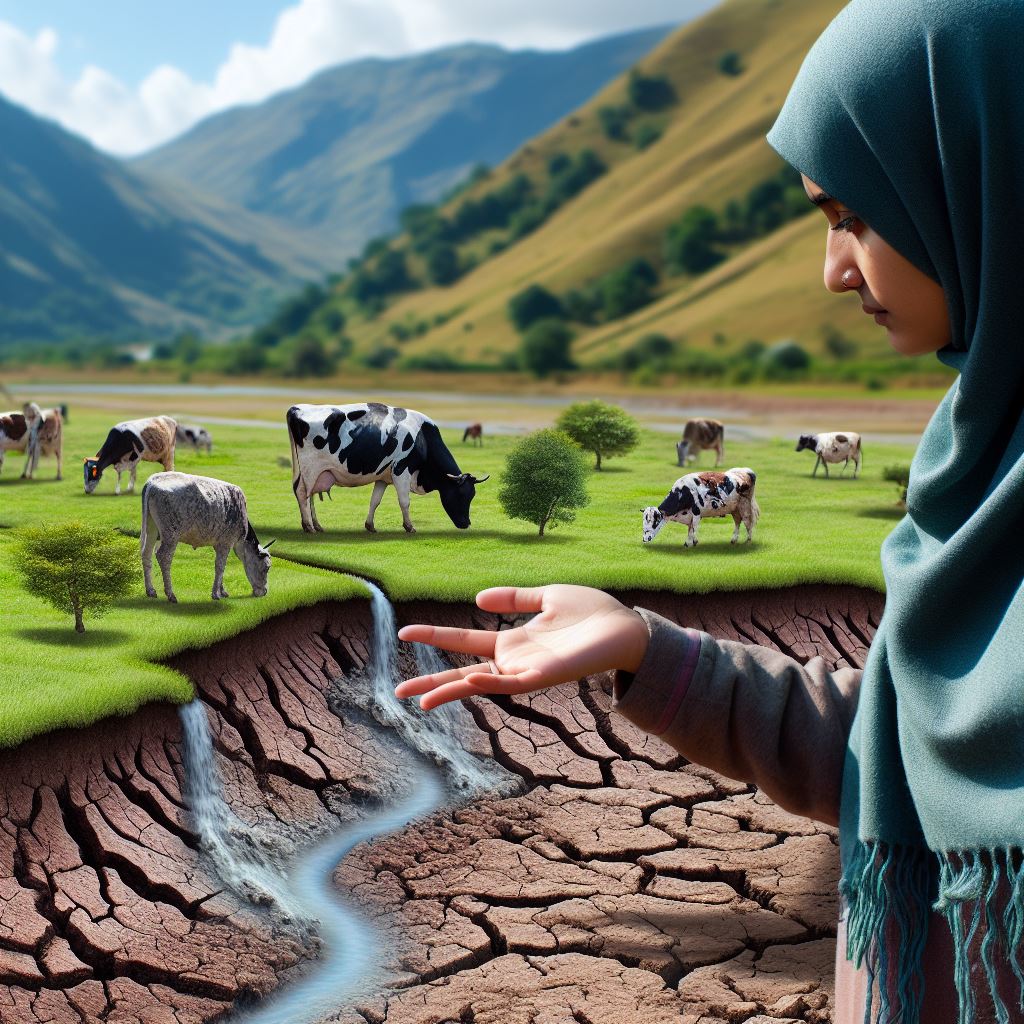Erosion Control in Grazing Lands
Last Updated on January 27, 2024
Introduction
Definition of erosion control
Welcome to our blog on erosion control in grazing lands.
In this section, we will discuss the definition of erosion control and its importance in grazing lands.
Importance of erosion control in grazing lands
Soil erosion is a natural process that occurs when wind, water, or human activities displace the top layer of soil.
In grazing lands, erosion can have severe impacts on both the environment and the agricultural productivity of the area.
Implementing erosion control measures in grazing lands is crucial to maintain the health and productivity of the land.
It prevents the loss of topsoil, which contains essential nutrients for plant growth and provides stability for vegetation.
Overview of the blog topic
There are various erosion control techniques that can be employed in grazing lands, such as planting cover crops, contour plowing, and constructing vegetative barriers.
These practices help to minimize surface runoff, retain soil moisture, and reduce the impact of water and wind erosion.
By protecting the soil from erosion, grazing lands can sustain their productivity and support healthy vegetation for livestock grazing.
Additionally, erosion control measures contribute to the conservation of water resources and prevent sedimentation in nearby water bodies.
Therefore, erosion control plays a crucial role in maintaining the health and productivity of grazing lands.
By implementing effective erosion control techniques, we can preserve the fertility of the soil, enhance water quality, and promote sustainable agriculture in these areas.
Stay tuned for our next blog section on specific erosion control practices for grazing lands!
Causes of Erosion in Grazing Lands
In grazing lands, erosion control is crucial to maintain the health and productivity of the land.
Erosion occurs when the topsoil, rich in nutrients and organic matter, is washed away due to various factors.
Understanding the causes of erosion in grazing lands is essential for implementing effective erosion control strategies.
Overgrazing
- Implement rotational grazing practices to allow for the recovery and regrowth of vegetation in various areas.
- Monitor and manage livestock stocking rates to prevent overgrazing of specific areas.
- Divide grazing lands into smaller paddocks to limit livestock access to prevent overgrazing.
Soil compaction
- Promote proper pasture management techniques such as avoiding grazing on wet soils.
- Improve soil structure through practices like aeration or mechanical cultivation to reduce compaction.
- Implement off-stream watering systems to minimize livestock trampling near water sources.
Lack of groundcover
- Implement reseeding programs to enhance vegetation growth and cover.
- Use cover crops or perennial grasses in grazing systems to maintain groundcover during non-grazing periods.
- Practice proper grazing management, including appropriate rest periods, to allow vegetation to recover.
Natural factors (e.g., rainfall intensity)
- Implement contour plowing or terracing to slow down the flow of water, reducing erosion.
- Utilize grass waterways or buffer strips to intercept and slow down runoff before it reaches vulnerable areas.
- Install erosion control structures such as check dams or sediment basins to trap sediment and prevent downstream erosion.
By understanding and addressing these causes of erosion in grazing lands, we can implement effective erosion control measures.
Through sustainable grazing practices, proper management techniques, and the promotion of vegetation growth, we can safeguard the health and productivity of grazing lands for future generations.
Read: Boosting Pasture Yield: Top Techniques
Effects of Erosion on Grazing Lands
Soil Degradation
Soil degradation is a significant consequence of erosion in grazing lands.
As erosion occurs, the topsoil is eroded, leaving behind less fertile soil.
This degradation happens because the topsoil is rich in organic matter, nutrients, and microorganisms, which are vital for plant growth.
When erosion takes place, it removes this valuable layer, making the remaining soil less suitable for sustaining healthy vegetation.
As a result, the soil becomes compacted, making it difficult for plant roots to penetrate and access essential nutrients.
Loss of Nutrients
Erosion in grazing lands also leads to the loss of vital nutrients from the soil.
The topsoil contains important nutrients such as nitrogen, phosphorus, and potassium, which are essential for plant growth.
During erosion, these nutrients are washed away and transported to other areas, depleting the grazing land’s fertility.
Without these nutrients, the soil becomes deficient and unable to support the growth of high-quality forage for grazing animals.
Reduced Productivity
Erosion has a significant impact on the productivity of grazing lands.
When the soil degrades and loses nutrients, it becomes less conducive for vegetation growth.
As a result, the overall productivity of the grazing land decreases, leading to reduced forage availability for grazing animals.
This decline in productivity can negatively affect the health and well-being of the animals, leading to decreased weight gain and diminished milk production in livestock.
Water Pollution
Another detrimental effect of erosion in grazing lands is water pollution.
As sediment-laden runoff from eroded areas flows into nearby water bodies, it carries pollutants such as fertilizers, pesticides, and animal waste.
These pollutants can contaminate the water, posing a threat to aquatic ecosystems and public health.
Excessive sedimentation in water bodies can also disrupt the natural balance of aquatic habitats, affecting the survival of various species.
In addition, increased sedimentation can result in the clogging of waterways and drainage systems, leading to flooding and subsequent damage to infrastructure.
Most importantly, the effects of erosion in grazing lands are significant and far-reaching.
Soil degradation, loss of nutrients, reduced productivity, and water pollution are just a few of the consequences that can arise.
Protecting grazing lands from erosion is crucial not only for the sustainability of agricultural practices but also for the preservation of natural resources and the overall health of ecosystems.
Read: Livestock Health: Pasture-Based Tips

Best Practices for Erosion Control
Proper erosion control on grazing lands is crucial to maintain soil quality and prevent environmental degradation.
By implementing best practices, landowners can mitigate erosion risks while optimizing land productivity.
In this section, we will explore three key strategies for effective erosion control.
Strategic grazing management
- Rotational grazing: Implementing a rotational grazing system allows for controlled grazing of different areas while providing adequate rest periods for vegetation to recover. This practice promotes the growth of healthy vegetation and reduces soil erosion.
- Rest periods: Allowing grazing areas to rest periodically is essential for maintaining ground cover. Rest periods let plants regenerate and protect soil from erosion caused by overgrazing. Smart management ensures a balance between grazing and regeneration.
- Proper stocking rates: It is important to maintain appropriate stocking rates to prevent overgrazing. Overstocking leads to excessive trampling and vegetation removal, accelerating soil erosion. Adjusting stocking rates according to land capacity ensures sustainable grazing practices.
Soil improvement techniques
- Soil testing and analysis: Regular soil testing and analysis help identify nutrient deficiencies, soil composition, and pH levels. This knowledge allows landowners to address specific soil needs through targeted interventions.
- Adding organic matter: Incorporating organic matter, such as compost or manure, improves soil fertility. Organic matter enhances water infiltration and retention, reducing runoff and erosion. It also contributes to the overall health of the grazing land ecosystem.
- Contour plowing: Contour plowing involves creating furrows along the natural contours of the land. This technique helps slow water runoff and prevents erosion by directing the flow along the contour lines. Contour plowing effectively traps water and prevents it from carrying away valuable topsoil.
Introducing groundcover
- Planting cover crops: Cover crops like clover or winter wheat provide temporary ground cover when grazing is not occurring. These crops protect the soil from erosion, add organic matter when incorporated, and promote nutrient cycling.
- Native grasses and legumes: Native grasses and legumes are well adapted to the local climate and soil conditions. They have extensive root systems that stabilize the soil, reduce water runoff, and contribute to overall erosion control. Planting native species helps restore the natural balance of the ecosystem.
- Mulching: Applying mulch, such as straw or wood chips, on bare soil effectively prevents erosion. Mulch acts as a protective layer, reducing the impact of rainfall and preventing surface crusting. In addition, mulch helps retain moisture, minimizes evaporation, and supports plant establishment.
By implementing these best practices, landowners can effectively control erosion in grazing lands, promoting soil health, and preserving the integrity of the ecosystem.
Strategic grazing management, soil improvement techniques, and the introduction of groundcover all contribute to sustainable land use and long-term erosion control.
Read: Essential Equipment for Modern Pig Farms
Cost-effective Erosion Control Methods
Utilizing natural barriers
Natural barriers are a cost-effective way to control erosion in grazing lands.
They make use of nature’s own mechanisms to prevent soil loss and protect the health and productivity of the land.
One such method is the use of windbreaks. By strategically planting trees or shrubs, wind erosion can be significantly reduced.
These barriers act as shields, slowing down wind forces and preventing the blowing away of topsoil.
They also provide shelter for livestock, further enhancing their importance in grazing lands.
Waterways are another natural barrier that can effectively control erosion.
Designed channels redirect water flow, preventing it from accumulating and causing soil erosion.
This method is particularly useful in areas with high levels of rainfall or runoff.
Careful engineering and proper maintenance ensure the long-term effectiveness of waterways.
Perennial vegetation strips are buffer zones consisting of permanent vegetation.
They serve as natural filters, trapping sediment and nutrients before they enter water bodies.
These strips can be strategically placed along slopes or near streams and ditches to intercept runoff and prevent erosion.
Not only are they cost-effective, but they also enhance biodiversity and provide habitat for beneficial insects and wildlife.
Installing erosion control structures
In some cases, natural barriers may not be sufficient to prevent erosion in grazing lands.
This is where the installation of erosion control structures becomes crucial.
These man-made structures are designed to manage water flow, reduce soil erosion, and enhance the sustainability of grazed lands.
Terraces are one effective erosion control structure.
They are level steps constructed on slopes to slow down runoff and prevent soil erosion.
By reducing the velocity of water, terraces allow it to infiltrate into the soil instead of picking up sediment and carrying it away.
Terracing also creates flat areas for grazing and cropping, maximizing land productivity.
Grassed waterways are another essential erosion control structure.
They are grass-lined channels designed to carry water and minimize soil erosion.
By providing a vegetated path for water runoff, they reduce its erosive energy while allowing sediment to settle.
Vegetation in grassed waterways also enhances nutrient cycling and provides habitat for beneficial organisms.
Sediment basins are yet another important erosion control structure.
They are constructed as detention ponds to capture sediments carried by runoff from grazing lands.
These basins allow sediments to settle at the bottom, preventing their transport downstream and reducing pollution in water bodies.
Regular maintenance and proper disposal of sediment are essential for their long-term effectiveness.
Maintenance and regular inspection
Despite the effectiveness of erosion control methods, regular maintenance and inspection are crucial to ensure their continued efficiency.
Monitoring the condition of natural barriers, erosion control structures, and vegetation strips is important to identify any signs of degradation or damage.
Maintenance activities may include removing debris, repairing damaged structures, and replanting vegetation.
Inspections should be carried out at least once a year, or after significant weather events, to address any erosion concerns promptly.
By investing time and effort in maintenance, landowners can maximize the benefits of erosion control measures and prolong their lifespan.
In essence, cost-effective erosion control in grazing lands can be achieved through the utilization of natural barriers, installation of erosion control structures, and regular maintenance and inspection.
By implementing these measures, landowners can protect their valuable resources, improve land productivity, and contribute to the overall health of the ecosystem.
Read: AI in Livestock Farming: Opportunities & Risks
Case Studies and Success Stories
Implementation of soil improvement techniques
- In a grazing land in Colorado, soil improvement techniques were successfully implemented.
- The techniques included contour plowing, terracing, and cover cropping.
- Contour plowing helped to prevent water from accumulating and causing erosion.
- Terracing provided leveled areas to control water flow and soil erosion.
- The use of cover crops helped in preventing soil erosion by providing ground cover.
- The implementation of these techniques resulted in a significant reduction in erosion in the grazing land.
Successful erosion control through strategic grazing management
- A study conducted in a grazing land in Montana demonstrated the effectiveness of strategic grazing management.
- The land was divided into smaller grazing areas and rotational grazing was practiced.
- This method allowed the land to rest and recover, preventing overgrazing and erosion.
- The strategic placement of water sources and salt licks also played a crucial role in preventing soil erosion.
- The success of this approach was evident as there was a noticeable improvement in soil stability over time.
- By implementing strategic grazing management, erosion was controlled, and the grazing land’s productivity was enhanced.
Benefit of utilizing erosion control structures
- A case study in Texas revealed the benefits of utilizing erosion control structures in grazing lands.
- These structures included grassed waterways, sediment basins, and retention ponds.
- Grassed waterways directed water flow, preventing erosion and sedimentation.
- Sediment basins trapped sediment runoff, reducing its impact on downstream areas.
- Retention ponds stored excess water, reducing erosion caused by flooding.
- The utilization of erosion control structures resulted in improved water quality and reduced soil erosion.
These case studies and success stories serve as examples of how erosion control can be effectively implemented in grazing lands.
Through the utilization of soil improvement techniques, strategic grazing management, and the use of erosion control structures, significant improvements in soil stability and water quality can be achieved.
By learning from these success stories, landowners and managers can implement similar practices to mitigate erosion and promote sustainable grazing practices.
Conclusion
Erosion control in grazing lands is crucial for preserving soil health and preventing environmental degradation.
By implementing effective erosion control practices such as contour plowing, terracing, and cover cropping, landowners can ensure the sustainability of their grazing lands.
This not only benefits the quality of the soil but also protects the water quality of nearby streams and rivers.
To further encourage the adoption of erosion control measures, a call to action is necessary.
It is essential for landowners and farmers to prioritize erosion control practices on their grazing lands.
By doing so, they contribute to the long-term viability of their businesses and help maintain a healthy ecosystem.
In final thoughts, I would like to emphasize the importance of educating oneself about erosion control methods.
There are various resources available, such as government agricultural agencies and local conservation groups, that provide valuable information and assistance.
These resources can offer guidance on selecting the most appropriate erosion control practices for specific grazing land conditions.
By working together and implementing erosion control practices, we can protect our grazing lands from the adverse effects of erosion.
Let us take responsibility for the preservation of our land and strive towards creating a sustainable future for generations to come.


